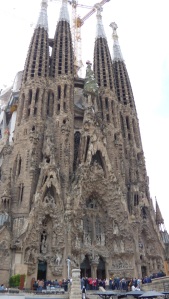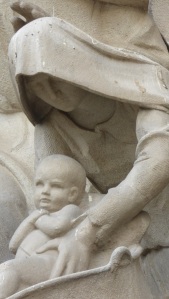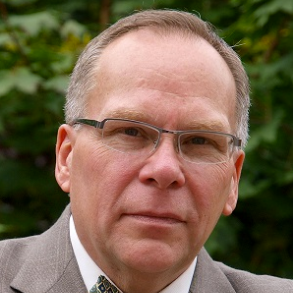This was the question Antoni Gaudi faced when the architect realized his great work, the Sagrada Familia, would not be finished in his lifetime. His solution is one that is still available to us today.

This past October I traveled to Barcelona, Spain to attend the International Leadership Association global conference where I was also privileged to present a paper. I also participated in a fascinating pre-conference workshop that introduced me to the life and legacy of Antoni Gaudi. It also included a tour of the Sagrada Famalia personally guided by our workshop leader, an architectural historian who had studied the life and work of Gaudi. By no means does one become an expert in Gaudi and his work in a day-long event. I did gain from this experience, though, a deeper understanding of collective leadership and its importance for collective impact.
The Sagrada Familia was conceived in 1866 as a holy offering to God by the Spiritual Association of the Devotees of Saint Joseph. Antoni Gaudi, himself a devout Roman Catholic, was named the second chief architect of the Sagrada Familia in 1883, within a year after building's first stone was laid. The first chief architect resigned in a dispute with the Association. Gaudi took over the project when he was 31 years old and guided it until his death at age 74.
The Sagrada Familia became, for Gaudi, the greatest and most meaningful work of his life. Gaudi came from a poor family and he struggled throughout his life to make a living. From 1883 to 1914 he worked other architectural jobs to support himself and even to purchase materials and labor to build the Sagrada Familia. It is reported that he gave much of his earnings to the project and was even known to beg passersby on the street for contributions. In 1914, sensing the project required his full attention if it were to be completed, Gaudi devoted his full time and effort to it. 
Still, this was not enough. Gaudi believed he would not live long enough to see the building completed, with good reason. In 1914 Gaudi was 68 years old and he had suffered from poor health all of his life. Chronically ill since childhood, during his conscripted service in the Spanish army as a young man he was often on medical leave. However, Gaudi did not die of any sickness. Only two weeks before his 75th birthday in 1926 he was accidently struck by a tram in the streets of Barcelona and died of his injuries in a pauper's hospital only three days later.
Whether it was prophetic, insightful, or just plain luck, Gaudi's realization and subsequent strategic choice in 1914 made it possible for his great work to be completed by others. Instead of continuing to focus on the actual construction of the building, Gaudi turned his attention to building the models and plans for others to follow. By the time of his death, Gaudi had finished enough that others could complete the project. Since 1926 there have been six other architects who have led the work and each has continued to build the Sagrada Familia according to Gaudi's original concept and models. The Sagrada Familia is scheduled to be completed in 2026 in recognition of the 100th anniversary of Gaudi's death. 
There are different ways to express collective or shared leadership. A common one is the simultaneous leadership of multiple people or groups. This is often how teams and collaborations work together. An individual or group steps up to provide leadership in an area of expertise while others do the same in their areas. Another expression of collective leadership is what Gaudi did with the Sagrada Familia. Despite his deep love, intense commitment, and nearly life-long ownership of the project, he opened and prepared the way for others to continue his work. Notably, while he created the concepts, models, and plans, he did not prescribe every decision and detail for his successors. In this way, they were free to interpret his vision and similarly own the project. Yet, the collective impact represented by the completion and overwhelming presence of the Sagrada Familia in Barcelona is undeniable.
Collective impact initiatives that result in durable social change need to be managed through collective leadership. While the collective leadership approach may be different for each collective impact initiative, one thing is true about each one: collective leadership begins with the individual.
This is my truth about collective leadership. It is less about techniques and tactics to help us become better at collective leadership; and mostly about individual attitude and will. Even if we had none of those tools and strategies, it would still be possible to engage in effective collective leadership. Why? Because we already have the skills. We learned them as children when we wanted to play well with others. We just need to rediscover and release that inner good playmate again.
Playing well with others is a choice. Confession: it is also part of my truth that I do not always choose to be a good playmate. Even if it is an unconscious choice, it is still a choice. When my "good child" comes out to play with others in collective leadership, it is typically because I have willfully made three personal choices:
1. Check ego. I do not mean "check" in the sense of making sure I have an ego. Of that I have no doubt. I mean "check" in the sense of making sure it is under control. Ego is about my right to authority. To check my ego is to intentionally lay down my right to the have the final word. This is a wholly internal process that is about changing my own attitude. After all, social change is not all about me, or you, for that fact. Social change is about creating a greater good for our world that we may not be around long enough to enjoy. If we will not check our ego, we are not yet ready for collective leadership. When we do, we are ready to move on to the next two things, which are now easier to do once we have checked egos.
2. Cross boundaries. Simply put, this means I invite others to work with me - especially those who are not very much like me. I do this because I know I cannot solve social problems by myself. I do this, too, because I know diversity of perspectives, experience, and ideas will result in an even better effort. Crossing boundaries has to take us out of our comfort zones or else we have not crossed anything. It is the only way for us to come in contact with and gather the kind of robust collective impact group members we will need to be innovative and energized. Sometimes, it even means we cross into the deep space of the conflict zone, to bring in people who are our critics and naysayers, especially when we know they share our end goal.
3. Share power. This is where it "gets real" for my checked ego. Once the group or team has been assembled, I need to work collaboratively with them to create the kind of space where each of us has an important and meaningful role in shared decision making and collective leadership. Power sharing in collective leadership creates ownership. Remember, Gaudi could have exerted immense power, even from his grave (which is in the building's crypt), by including instructions on every intricate detail of the Sagrada Familia. If he had, he probably would not have actually finished even the planning before his death. Even more, his successors might have grown to resent feeling compelled to finish his great work rather than develop a deep sense of ownership of their joint project.
This week (January 18, 2016) we remember and honor the life and legacy of Dr. Martin Luther King, Jr. in the United States. The question that opened this post is one that he seems to have been wrestling with as well just prior to his last speech in Memphis, Tennessee:
Through the collective leadership of Dr. King and those whom he gathered around him in the Southern Christian Leadership Conference, he found a way to ensure his great work would continue, even to this day. Today none can deny the collective impact of the civil rights movement in the United States.
I have been and remain convinced the fuel of collective impact includes collective leadership. I believe these three personal things can strengthen our collective leadership efforts for collective impact.
Be greater. Do good. Every day.





